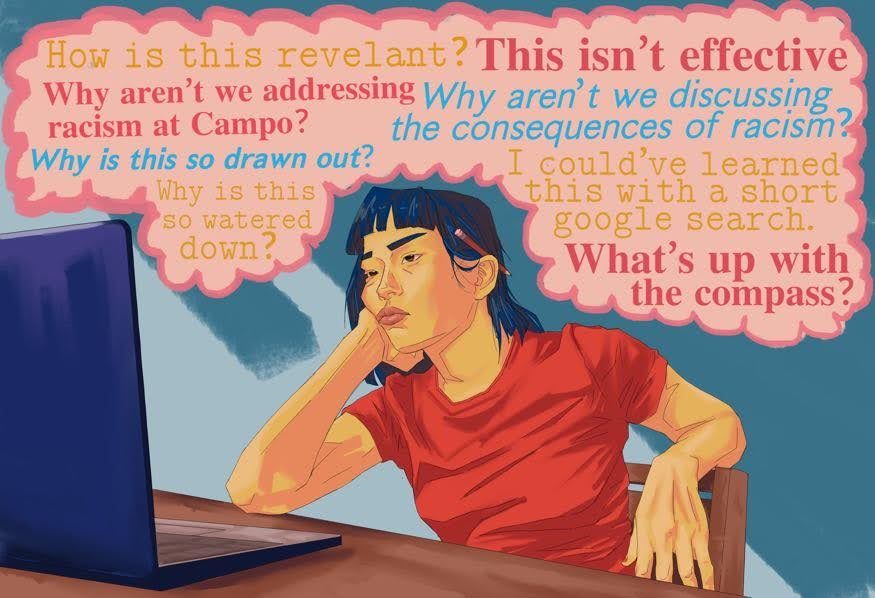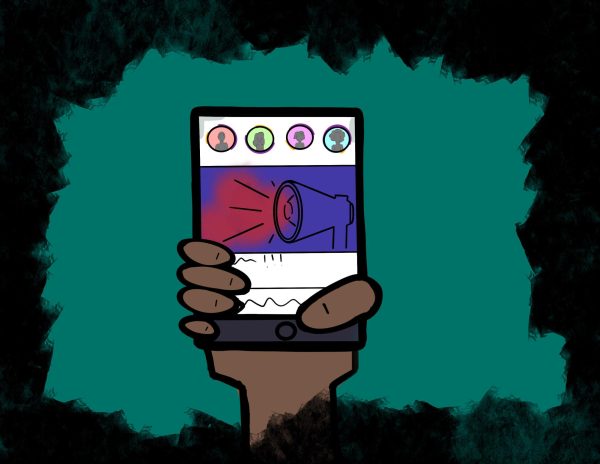Cohort Equity Training is Ineffective
So are we going to talk about systemic racism?
In response to distance learning, Campolindo hoped to create a sense of community through the new addition of the Cohort Academy, a homeroom of 20 students and a teacher.
These cohorts work to foster an inclusive environment and address racial equity through modules designed by Dr. Lori A. Watson.
Given the racist video resurfacing during the summer of Campolindo students using racial slurs, student testimonies regarding instances of racial bullying, and other issues in our country like the death of George Floyd, the administration worked over the summer to address these issues.
The courses taught were unimpressive. This equity training spent too much time talking about irrelevant subjects, like the scientific definition of race, instead of the actual social issues happening all over the world.
An excerpt from The Welcome to the Canvas Race & Equity Course modules stated, “If we don’t understand our own racial experiences and perspective, we can’t understand anyone else’s perspective.”
However, the actual implementation of this equity training into cohort academies was poorly thought out. Talking about our experiences regarding race in a Zoom meeting with 19 random peers is not going to magically fix the lack of respect and inclusion at Campolindo. It’s uncomfortable enough to stare at your peers, waiting for someone to say something. Unmuting yourself in class to ask a math question is 1 thing, but asking students to share instants of bias or experiences with racism is a whole other thing.
“I didn’t find [equity training] that engaging,” said sophomore Maya Gottfried. ”I thought there was good material there to watch and talk about, but I don’t think the material was given to us in the best way.”
Principal John Walker realizes that because the racial equity training is new, it will not be perfect for educating students of all grades. “I think some of the cohorts [are geared] for the older students. They’re ready to have a much deeper conversation about it, and they obviously have more experience about Campo culture and how students are and are not included. Whereas for the freshman, you know this is very introductory,” said Walker.
Given these discoveries, Walker hopes to tailor the conversations in cohorts in a way that is more accessible to each grade level.
However, the material covered in Cohorts felt more like busy-work than a mature discussion. For example, 1 of the course’s lessons involves a 4-sectioned compass. The sections were labeled “believing, thinking, feeling, and acting,” and students were asked to explain what quadrant they felt associated with when talking about race.
It makes no sense why we referred to the compass multiple times during our training, but spent less time actually discussing the real issue of racism on Campolindo’s campus.
Activities like this compass simply distract students from the larger issues like race and lack of inclusion. Ultimately, this compass felt like a way to make non-minority students feel more comfortable talking about race; instead of tiptoeing around the subject, the district should push us to feel uncomfortable to truly change the problematic behaviors of certain members of the student body.
This training came to be in the 1st place because students of color have reported instances of racism on our campus. We should be addressing that rather than delving deeply into how race is a social construct or explaining where we are on the compass.
“I think we should just be more straightforward,” said sophomore Kevin Humphreys.
Humprheys believes that the equity training in cohort academy is “drawn out and slow” when the class could cover the subjects more in depth for a shorter period of time.
Humphreys is not alone. According to a survey on La Puma’s Instagram, 68%of 331 surveyed people thought Campo’s Academy Cohorts equity discussions were ineffective in promoting change.
However, students proved that they value the idea of promoting equity, as 65% of surveyed people approve of the introduction of equity training in general. Clearly, students are ready to have these conversations, the district needs to provide a better structure for our training.
These training sessions could be more concise, productive, and relevant to have any hopes of creating a healthy, inclusive environment. Students should be taught how to have the mindset to respect everyone and how to step up when they witness or experience an instance of racism.
I realize that the administration had good intentions with introducing this training, and the argument that we need to address instances of hate at Campo is valid. However, I think that this could’ve been dealt with in a more effective, educative manner to actually reform the issues on our campus. Racism on our campus will not be fixed by forcing people to share their feelings in breakout rooms with random peers, but we need better content in the equity training if it’s to be effective.
Your donation will support the student journalists of Campolindo High School's The Claw. Your contribution will allow us to produce more issues and cover our annual website hosting costs.

Sophomore Thomas Singh likes running for the Campo cross country and track teams and has a passion for reading, especially historical fiction.
This...


